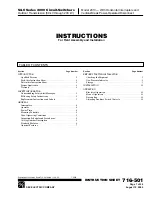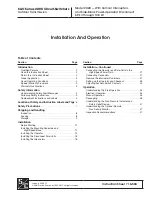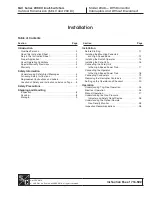
Mypower
S4100
Troubleshooting
Maipu Confidential & Proprietary Information
Page
65
of
124
Possible Reasons
Judging Methods and Solutions
The loopback test cannot
block the port-to-port loop.
The loopback tesyt can only check the loop in the single port.
The port-to-port loop should adopt the spanning tree to block.
Some ports ate impacted by
lots of loopback test
packets.
The downstream devices of some ports have the remote loop
and as a result, lots of loopback test packets impact the CPU
queue, the loopback test packets of other ports cannot be
processed, and the loopback test function of the ports becomes
invalid. The administrator needs to shut down the port whose
downstream network has the loopback test packet storm.
Fault 2: The loopback test is not stable.
Possible Reasons
Judging Methods and Solutions
The downstream network of
some ports has the remote
loop and the broadcast
storm appears. As a result,
the loopback test packets
are lost.
If the downstream network has the remote loop, which causes
the broadcast storm, the loopback test packets are easy to be
lost. As a result, the loopback test becomes unstable and the
ports switch between FORWARDING and BLOCKING
repeatedly. Once the problem appears, the administrator
should shut down the faulty ports, check the downstream
network, and delete the remote loop with the broadcast storm.
Fault 3: The port cannot recover FORWARDING after disabling the
loopback test.
Possible Reasons
Judging Methods and Solutions
After the port is blocked by
the loopback test, use the no
loopback-detection
enable command to disable
the loopback test and then
FORWARDING cannot be
recovered.
Execute the command no loopback-detection enable on
the port blocked by the loopback test to disable the loopback
test. The loopback test packets still keep sending and maintain
the block state until the loop is removed. To disable the
sending of the loopback test packets forcedly, you need to
execute the no loopback-detection enable force
command.
Fault 4: There is the port-to-port loop, but there is no alarm during the
loopback test.
Possible Reasons
Judging Methods and Solutions
The enabled spanning tree
loop is blocked by the
spanning tree.
The spanning tree blocks the port-to-port loop and the
loopback test does not alarm. Generate alarm only when there
is port-to-port loop, which is not blocked.
The loop ports all need to
enable the loopback test.
The two ports that form the loop both need to enable the
loopback test, so as to generate alarms for the loop.
















































